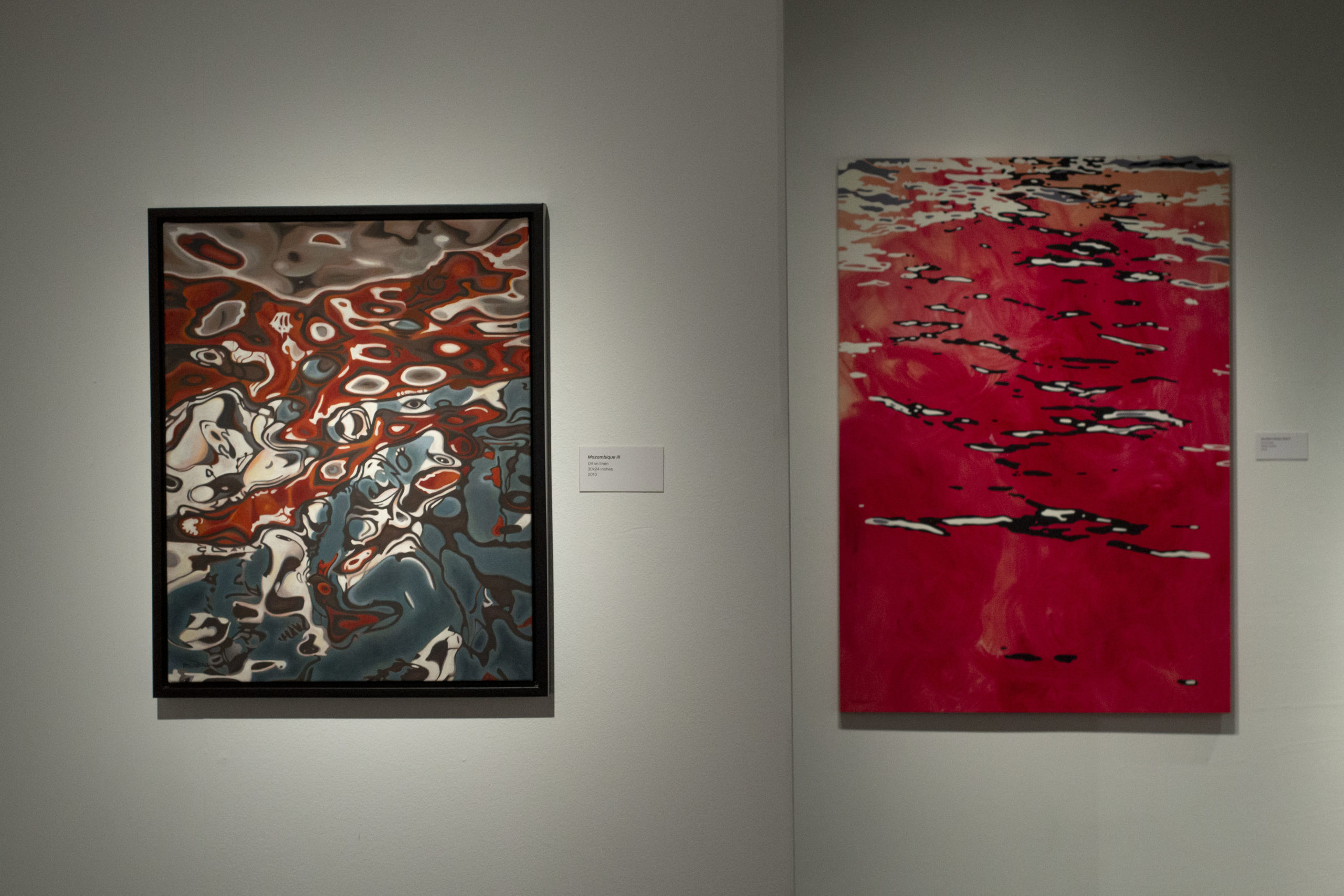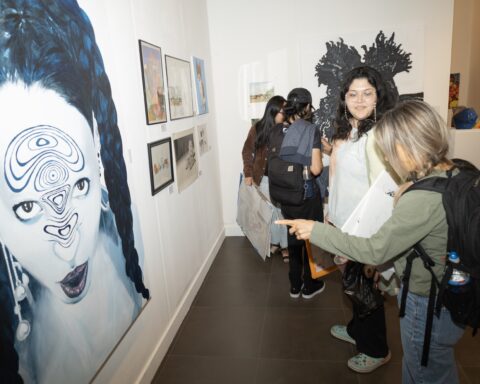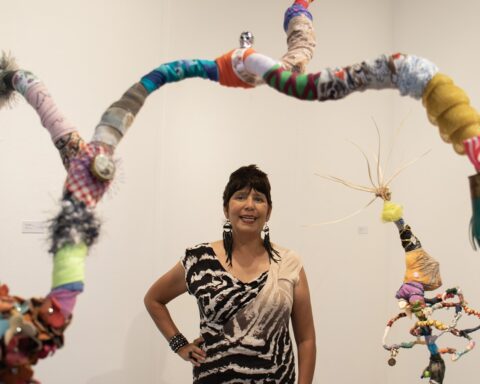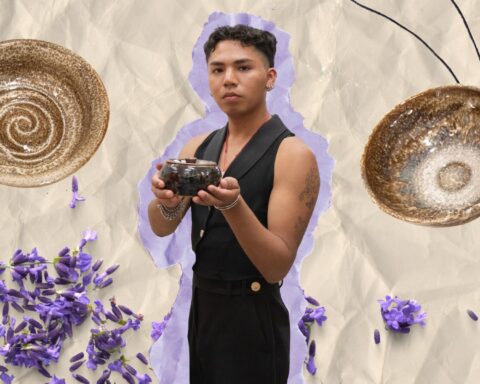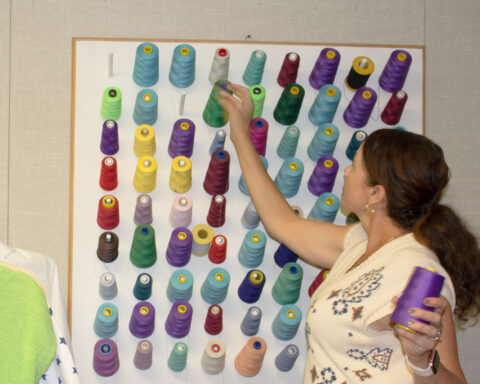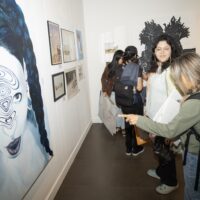Los Angeles based artist Danielle Eubank has a vivid memory from her childhood, one which involves her sitting and staring at the Pacific Ocean, thinking to herself ‘I’ll never be able to draw that.’ In a way, she was right. Because she doesn’t draw landscapes of the sea. Instead, she paints highly-abstracted versions of all five of our oceans— a feat which took her 20 years and four sailing expeditions to accomplish. Her collection, titled “One Artist Five Oceans,” is now available for viewing in the main gallery on campus until April 7.
The exhibit’s original opening took place on Feb. 12 and included a lecture given by Eubank herself. I was able to speak with her more personally on the phone the following week. Over the course of our interview, she provided me with endless insights on who she is as an artist, how she got there, and what it was about this project that enticed her to commit herself so fully:
If you could just introduce yourself, tell me a little about you. Who is Danielle Eubank?
My name is Danielle Eubank and I’m an artist. Primarily, I paint oil on linen and I paint images of water which are highly abstracted. I have other interests as well. One of the primary ones is doing whatever I can do to help mitigate climate change and making sure that our oceans and waterways are as clean as possible.
Tell me a little about how you got into art, how old were you when you first began painting?
Well, I mean, like a lot of little kids I was always really into art. What I loved about art was that I could make things and give them to people. I really liked giving people pictures. I don’t know if they wanted them, but it was a way to give people things. So that was one of the things that I really liked about it.
When I was about 8, my family spent about 6 or more months in Europe because my dad had a […] scholarship and so we traveled through Europe. That was my opportunity to see some of the great works, like a lot of the Michelangelo works and things like that. I remember looking at some of the Michelangelo works on the wall and on the ceiling in the Sistine chapel and some of his sculptures. I remember thinking ‘wow, that’s what I want to do.’ I was so little that I didn’t really get it, I thought ‘I want to be Michelangelo.’ I didn’t actually sort of put that together all the way, but that was a real eye opener seeing all of the classical pieces when we traveled.
And so what sort of art do you make? The style or medium you use? And why have you chosen to make it that way?
Yeah. I don’t think I can really speak for other artists, but I don’t think you really choose a style. I think a style is something that’s your own. Something that you develop over time.
I like painting on linen because it’s very flexible, right? It gives a lot when you push on it, because I push really hard on the substrate. And the other thing I really like about linen is that it lasts for a really long time. A linen painting will last hundreds of years, whereas a regular cotton canvas painting might with good care last a hundred years.
What pieces are displayed at SAC and what is the significance of them?
Sure. So what I have on view there is examples of each of the oceans on the planet. And the paintings go with stories or descriptions of each of the five oceans that SAC students have written.
How did you originally come up with this idea? Did it seem far fetched at the time or did you always know it was a project you needed to execute?
It seemed very far-fetched at the time, that’s an excellent question. I was an expedition artist first and had been on one or two expeditions. I had painted at least the Indian Ocean and the Atlantic ocean, which very much opened my eyes to how big the planet really is and how much is out there.
I don’t think we get quite the same sense of that when you fly in a plane. You know, you go to an airport and a lot of airports are all pretty similar to each other. Then you fly and you get off at another airport that’s pretty similar to the first one. And then you get out and it’s different and exciting, but I think that kind of travel really shortens the distance so much that it’s hard to grasp just how large the earth is.
After sailing for a little while, this kind of dawned on me and I fell in love with the ocean in a way that I never had. Because I grew up pretty close to the ocean, but the ocean wasn’t some place you could swim and it was kind of cold and the sand was kind of coarse. It was beautiful and you could play frisbee, but it had a certain austerity to it. After traveling on the vast expanses of the open sea I had a different appreciation for it.
What about water and the ocean led you to focus solely on it as a subject?
When I was in Ronda, Spain, with a friend of mine, we traveled down to Doñana National Park to look at a protected area for animals. It has the largest biodiversity of anywhere in Europe and it’s this fantastic place my friend had suggested we go to. So I thought, ‘fabulous, let’s go down there. I want to see some Iberian lynxes. I’ve never seen an Iberian lynx before, that sounds like fun.’
So we went down there and went camping. I was painting and we were both working on our spanish. What I didn’t realize, in my ignorance, is that you weren’t allowed more than 50 meters inland from the water. I wasn’t interested in painting the water. I had no interest in painting the water, up until that point.
I think because I grew up near the water, so I’d seen an awful lot of paintings of the ocean, I didn’t really see how I could lend my voice to that in a way that was original and fresh. So I spent several days with my back to the Atlantic ocean painting the dunes. We were sort of stranded on this beach, which is not a terrible thing.
But then, after several days of painting the dunes, I turned around. And I literally sat down on the hot sand and stared at the water. It was a beautiful, beautiful day. Not a single cloud in the sky, it was this dark blue color. The ocean was perfect and clean. The sand was this even, light color.
I just sat there and looked at it and thought, ‘Okay, I’m going to have to figure out a way to paint you.’ You know, like, ‘you’re really fantastic and lots of people have painted you in the past, I’m going to conquer this. I’m going to find a way to paint you in my own voice that’s fresh and give you your proper due.’
One of your paintings in the gallery that I personally loved is titled Tamsui. Could you tell me a little bit about this painting or your time in the area it was created?
Yeah. So I think it’s the Tamsui river, which gives into the pacific ocean. Tamsui is a town and a river a little ways from Taipei. I was on vacation, I have family that live in Taiwan and so we were visiting there for the first time. I was really appreciating this place and it was hot and rainy, because it’s the tropics. It was stunning and I was in love with every single thing I saw.
Probably that’s what’s coming through because it was this kind of hot and rainy day where I was in love with everything that I saw. I think that’s sometimes how we create the best work, when you’re really into something and you try to capture it and you don’t realize that you’re putting some of that emotion into it.
That’s what I love about your work, though. I like seeing how you capture a feeling instead of exactly what it looks like.
Thank you, no, thank you. That’s definitely what I’m trying to do. I’m trying to evoke something in the viewer and I guess I’m expressing my own emotions as well. That’s one of the differences between expressionism, where you’re expressing something, and impressionism, which is a totally different style. You’re interested in how that message is being decoded, versus expressionism where you’re interested in what message you’re decoding. And I don’t know where my work sits in that all, but I guess I’m sort of both.
Were any of the five oceans you painted especially hard to conquer? Or especially difficult to capture?
Yeah, I had a really hard time with the arctic because it was so abstract. I touched on this a little bit in the lecture, but I’m interested in abstracting these bodies of water and then I arrive at this ocean that’s already abstracted.
I mean, it didn’t make any sense. The sun didn’t come up, quote/unquote, properly. The moon didn’t go down properly. The earth, the actual soil, didn’t act properly because of permafrost— it was frozen. The houses weren’t sort of what I was used to because of the permafrost. They were all sort of leaning over because the pipes and the foundations and everything are in this frozen, liquid goo known as permafrost.
I could go on and on and on. Nothing about it was what I was used to in my small, middle-earth existence.
Could you explain your process of creating these paintings as an expedition artist? Walk me through the steps of a typical painting in this collection.
Yeah, absolutely. So if I’m on an expedition, I usually take three sketchbooks with me: a small one, a big one, and a bigger one.
I like to have a small sketchbook with me because I can kind of just stick it in my pocket and have it on me at all times in case I see something that I just wanna jot down.
The big and the bigger ones are for working out ideas. I paint with oil paint in the sketchbook and I precoat them so that they have an oil ground on each page. I take thousands of photographs because, usually, when I am on a boat I’m also busy doing something else.
You know, I might have crew duties or it might be extraordinarily cold or raining or the boat might be moving a lot. In which case, it’s good to have those photographs so I can refer back to what I saw.
Then when I’m back in the studio, I’ll have these sketchbooks full of sketches and I’ll look through my photographs because sometimes you see things you didn’t see at the time. Because you’re in the experience you’re not able to see everything that’s around you.
And I’ll think about my feelings. I’ll think about, ‘was this a warm feeling or a cool feeling? Was it scary? Was it fun or playful?’ All of these different things.
And then I’ll start thinking through compositions that work to express that. And then sometimes what I do is I will think about the composition first, right? Like what would happen if I had a wave going vertically? What would happen if I weighed all of the dark hues on one side and had the other side be very, very light? There’s a painting like that in the exhibition as well. Or what would happen if I had opposite colors playing off of eachother? Like blues and oranges. And what would that evoke?
So the first example is I’m trying to evoke a certain kind of feeling, ‘let’s do it.’ And the second one is, ‘hey what would happen if we did this on a canvas? What would that evoke?’ Because I don’t know. I have kind of an idea of what I want it to be, but I don’t know until I put it in front of people.
How did you discover that you could blend your passion for bringing awareness to climate change and painting into one?
I’ve always been interested in environmental issues, ever since I was little. I’m from California and we’ve always had water issues, right? And where I grew up we had our own well, and there were times where we had to be extremely vigilant on how much water we used.
You could see pollution. I heard stories from my grandmother who grew up in what used to be called Eduanda near Laverne, which is now Rancho Cucamonga, about how it used to be clear. The skies were clear and then they came up with this crazy word, which was a cross between smoke and fog, to describe the air in California where she lived.
Those things affected me a lot. Also, you know, when I was a kid it was talked about frequently about how various species were going extinct and how DDT was hurting bird populations. How it was a persistent chemical which would live right on top of the food chain, if you will.
I don’t like that word, food chain, because it implies that everything is about eating. You know, the food web? Ah, that’s also bad. Anyway, the environment and all of the animals all the way up to the apex creatures, like ourselves.
So it doesn’t matter that I’m an artist in terms of my interest for the environment. Any profession that I was doing that would end up being part of it. That’s just something that I care about.
You’ve been quoted as saying that you always feared painting water because it seemed too hard to capture. Do you have any advice for young artists or our students who have a vision or a dream of something they want to create but find it to be too daunting to even try?
Yea, I would say keep chipping away at it. You’d be surprised at how quickly time passes. And sometimes you think that you haven’t accomplished anything. Sometimes you think ‘oh, i’m just starting out. How am I ever going to do this?’
But if you keep chipping away at it, when you look back a couple of years later and start putting together your resumes you realize ‘oh, wait. I did this and I did this, that’s pretty cool. I didn’t realize I had gotten that far.’
I think being true to your passion and trying not to worry about all the noise. There’s a lot of noise, right? What do people think? Not just with social media. With or without it, all of these people look like they’re having these fabulous, beautiful lives. You can kind of get in your head about it.
I would say get that word “should” out of your mind and think about what you want to do. Not what I should do, but what I want to do.
Some people are very fortunate, some people are not. I mean, I didn’t grow up with any means of any kind. So if I can do it, anyone else can do it.
- Faculty and alumni keep theatre performances alive - May 19, 2022
- Women in Horror: The Evolution of The Final Girl - May 4, 2022
- Q&A with artist Danielle Eubank about her on-campus exhibition of ocean paintings - March 1, 2022


